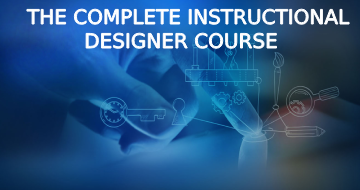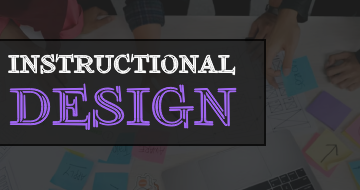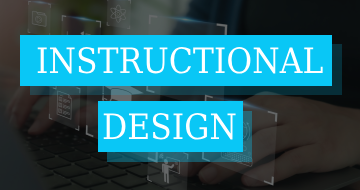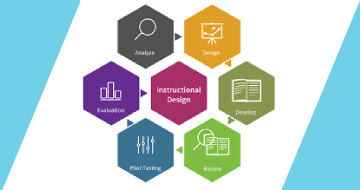IIRF Online > Business > Human Resources > Instructional Design > Instructional Design for ELearning
Instructional Design for ELearning by Udemy
Learn everything you need to know to design successful eLearning courses (Bonus: A complete ChatGPT guide for L&D
Course Highlights
- Define the terms instructional design, eLearning, and blended learning
- Describe the difference between computer-based training and web-based training
- Identify and describe advantages and disadvantages of synchronous and asynchronous eLearning
- Determine whether eLearning is the appropriate solution for your needs
- Select the most appropriate ISD model for your course
- Apply the principles of behaviorism, cognitivism and constructivism to your course design
- Apply the concept of andragogy and Malcolm Knowles’s six principles of adult learning to your course design
- Analyze learning styles and apply suitable presentation methods and techniques that address multiple learning styles
- Differentiate between intrinsic and extrinsic motivation
- Apply John Keller’s ARCS Model of Motivational Design to your eLearning course
- Determine the role long-term memory, short term memory, and working memory play in learning
- Discover ways to avoid Cognitive load in your course design
- Use Ruth Clark’s six principles of effective eLearning courses to create eLearning experiences
- Conduct audience analysis, performance gap analysis, and task analysis
- Utilize appropriate data collection methods and techniques to conduct needs analysis for your eLearning courses
- Write terminal and enabling learning objectives using the A-B-C-D format
- Apply Bloom’s Taxonomy and three learning domains when writing your learning objectives
- Use Robert Gagné’s Nine Events of Instruction to design effective learning experiences
- Select appropriate presentation methods and techniques that adhere to the Nine Events of Instruction
- Create a Design Document with appropriate sections and information in each section
- Design and develop storyboards and prototypes for your course
- Script your eLearning courses using plain language principles and style guides
- Conduct alpha, beta, and pilot testing to confirm functionality of your course
- Develop error log for piloting courses
- Differentiate between the Learning management System (LMS) and Content Management System (CMS)
- Use guidelines for creating SCORM-compliant content
- Use Reusable Learning Objects (RLOs) to develop courses in the cheapest and fastest way possible
- Design Section 508 compliant training materials
- Apply Kirkpatrick’s Four Levels of Evaluation to eLearning courses
- Describe the relationship between Needs Analysis and Kirkpatrick’s Four Levels of Evaluation
- Use the ROI model to compare the monetary program benefits with the program costs
- Develop different types of valid and reliable assessment items
- Provide intrinsic and extrinsic feedback to learners
- Differentiate between the four levels of interactivity and select the most appropriate level for your course
- Choose linear or non-linear navigation and layout for your course
- Select the appropriate type of game using appropriate gamification elements
- Design the learning game that helps learners understand and retain the content
- Select eLearning authoring tool appropriate for your needs
- Develop courses in Articulate Storyline, Articulate Rise, and Captivate
- Describe the three types of videos in eLearning
- Select your talent
- Self-produce your eLearning videos
- Design and develop screencasts for your technical training courses
- Record audio narration
- Design effective graphics for your courses using Ruth Clark’s visual design model
- Identify roles and responsibilities of Subject Matter Experts (SMEs) in course design
- Collaborate with SMEs to collect content and select appropriate information for the course
- Manage eLearning courses using the IPECC Model and Project Management tools
- Design effective job aids and Electronic Performance Support Systems (EPSs)
- Incorporate social networking tools in eLearning courses
- Create podcasts and vodcasts for eLearning
- Design courses and supplemental materials for social and mobile learning
- Use agile methods and techniques to design eLearning experiences
- Identify situations when Performance Improvement interventions are needed
Skills you will learn!
Curriculum
11 Topics
Introduction
Instructional Design and ELearning
Instructional Design and ELearning
Instructional Design Models
Instructional Design Models
Learning Theories
Learning Theories
Motivation
Motivation
Memory
Memory
21 Topics
Introduction to Section 2
Needs Analysis and Data Collection Methods
Needs Analysis and Data Collection Methods
Learning Objectives
Learning Objectives
Designing the Learning Experience: Gagné’s Nine Events of Instruction
Designing the Learning Experience
Creating a Design Document
Creating a Design Document
Storyboarding
Storyboarding
Scripting Your ELearning Course
Scripting Your ELearning Course
Quality Assurance
Quality Assurance
Implementation
Implementation
Evaluation
Evaluation
Assessments
Assessments
13 Topics
Introduction to Section 3
Interactivity in Your ELearning Course
Interactivity in Your ELearning Course
Simulations and Games
Simulations and Games
ELearning Authoring Tools
ELearning Authoring Tools
Video in ELearning
Video in ELearning
Audio in ELearning
Audio in ELearning
Graphics in ELearning
Graphics in ELearning
15 Topics
Introduction to Section 4
Working with Subject Matter Experts (SMEs)
Working with SMEs
ELearning Project Management
ELearning Project Management
Job Aids
Job Aids
Web2.0 and Mobile Learning
Web 2.0 and Mobile Learning
Agile ELearning
Agile ELearning
Performance Improvement
Performance Improvement
Summary
BONUS: Becoming an Instructional Designer- What does it take?

Instructional Design for ELearning



.webp)





